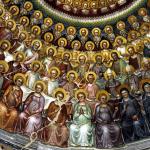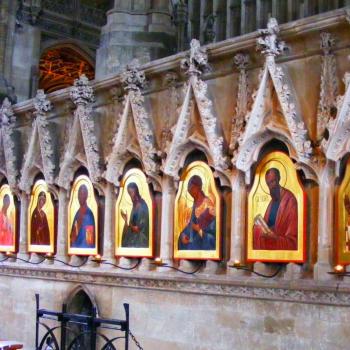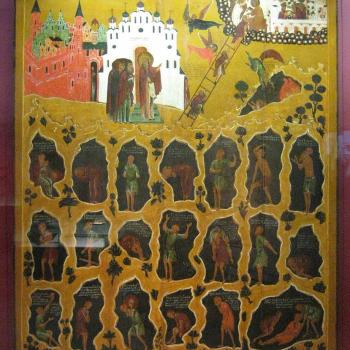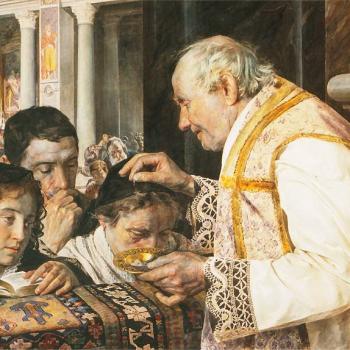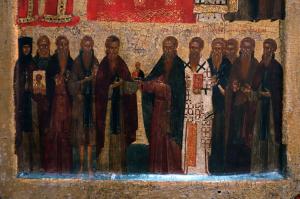
Images of the saints, as well as of Christ, are not only permitted, but should be used as aids in our worship and as a way for us to experience the kingdom of God in our temporal existence. In a way, they can be said to be windows into heaven, as in and through them, we get a glimpse of glorified existence. The reason why they are acceptable is because of the incarnation. God became one of us. Because the Logos, a divine person, has assumed human nature, the Logos can personally be perceived by the physical senses, and so portrayed in and through an image. It is also important to remember, however, that even before the incarnation, each human person was said to be made in the image and likeness of God, so that in and though each human, and whoever and whatever else could be said to be made in the image or God, there was a way to depict the divine image, not exactly the same way as it can be and is found in Christ, but one which nonetheless a way which can be said to be engaged when the saints are depicted in and through images. It is also possible to say the depiction of the saints is also acceptable because of their unity with Christ, so that because Christ can be imagined with a holy image, so those joined in with him can be as well.
We should not only defend the use of images, we should protect them from those who would otherwise deny their use and seek to destroy them. This is true in regards the holy icons and statues which are made to help us encounter the images of the saints, but it is also true in regards the image and likeness of God found in every person. Those Christians who would hurt the poor, the migrant, the widow, the orphan, the social outcast, even, indeed, the criminal, are doing so to someone who holds the image of God in them, and so they are also attacking God’ image.
Orthopraxis must follow orthodoxy. It is not enough to know the truth, or some aspect of the truth. One must act upon the elements of the truth one has received. And, insofar as such images of God are defiled when others are needlessly hurt and trampled upon, such as a migrant is who spit upon or killed by someone who is xenophobic, to defend God’s image Christians must protect anyone and everyone who has been dehumanized so as to have their human dignity denied them. They must do their part, likewise, to help them have their human dignity restored. Christian orthodox cannot remain theoretical.
We are, therefore, are “surrounded by so great a cloud of witnesses” (Heb. 12:1a RSV) of God in and through each person who imagines God in their very personage. We are to look at “Jesus the pioneer and perfecter of our faith” (Heb. 12:2a RSV) who, in the incarnation, lifted up humanity and the image and likeness of God found in it, restoring to it what it had lost due to sin. We are to follow his example, and continue that restorative work. We are to heal the harm done to others due to the way they have been mistreated and abused. We are to lift them up before others so that they can get the dignity and respect they deserve.
Similarly, we are to look to the saints, and see how they present the glory of God in and through the way they have taken on grace and let it transform them, to become even greater than what they could have been without it. They represent, through their integration with grace, the glorification or deification of the world.
Jesus knows us all, and asks us to come follow him. He knows us more than we know ourselves. He knows our potential. He knows the kind of person we are but also the kind of person we can be if we accept grace and let it transform us. Certainly, like with the apostles, when they found Jesus calling them with his intimate knowledge of them, this can and should make us filled with awe:
The next day Jesus decided to go to Galilee. And he found Philip and said to him, “Follow me.” Now Philip was from Bethsaida, the city of Andrew and Peter. Philip found Nathanael, and said to him, “We have found him of whom Moses in the law and also the prophets wrote, Jesus of Nazareth, the son of Joseph.” Nathanael said to him, “Can anything good come out of Nazareth?” Philip said to him, “Come and see.” Jesus saw Nathanael coming to him, and said of him, “Behold, an Israelite indeed, in whom is no guile!” Nathanael said to him, “How do you know me?” Jesus answered him, “Before Philip called you, when you were under the fig tree, I saw you.” Nathanael answered him, “Rabbi, you are the Son of God! You are the King of Israel!” Jesus answered him, “Because I said to you, I saw you under the fig tree, do you believe? You shall see greater things than these.” And he said to him, “Truly, truly, I say to you, you will see heaven opened, and the angels of God ascending and descending upon the Son of man” (Jn. 1:43-51 RSV).
The heavens can be and should be open up to us. We should perceive mentally, if not also physically, the great cloud of witnesses which is all around us. We should realize we are connected to those who came before us, that they are a part of that cloud of witnesses, even as we are connected with those who are alive, who, likewise, are a part of that same cloud of witnesses. We should do what we can to realize the truth of this, for, as Fr. Maloney once wrote:
When the Church is vibrant with deeply contemplative Christians, the understanding of communion between the living and the dead becomes a great, living reality. The contemplative lives on a deeper plane of reality, seeing no great chasm separating them from their living neighbors for whom they intercede before the throne of God. Such Christians feel united also in prayer with all the departed, the saints, angels, and those not quite brought into the fullness of God’s glory through sufficient healing of the earth’s hurtful relationships, even those in the state of complete alienation from God, in the state of hell.[1]
We, therefore, are called to discern the image of God in all things. We are to take care of those images, making sure they are not defiled, and if they are, to do what we can to help them be cleansed from their defilement and receive the honor and glory they should have given to them due to the fact they imagine God. For when we do that, we not only honor them, but we give God even greater honor, by showing respect to the divine image.
[1] George A. Maloney, SJ, Communion of Saints (Hauppauge, NY: Living Flame Press, 1988), 36.
Stay in touch! Like A Little Bit of Nothing on Facebook.
If you liked what you read, please consider sharing it with your friends and family!
N.B.: While I read comments to moderate them, I rarely respond to them. If I don’t respond to your comment directly, don’t assume I am unthankful for it. I appreciate it. But I want readers to feel free to ask questions, and hopefully, dialogue with each other. I have shared what I wanted to say, though some responses will get a brief reply by me, or, if I find it interesting and something I can engage fully, as the foundation for another post. I have had many posts inspired or improved upon thanks to my readers.


